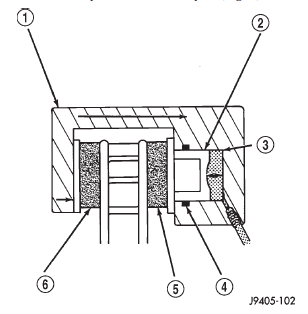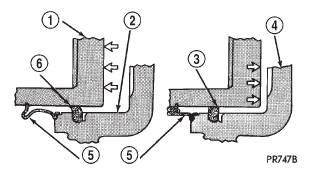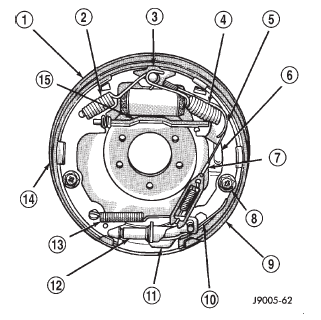Description and operation
Description This vehicle is equipped with front disc brakes and
rear drum brakes. The front disc brakes consist of
single piston calipers and ventilated rotors. The rear
brakes are dual brake shoe, internal expanding units
with cast brake drums. The parking brake mechanism
is cable operated and connected to the rear
brake secondary shoes. Power brake assist is standard
equipment. A vacuum operated power brake
booster is used for all applications.
Two antilock brake systems are used on this vehicle.
A rear wheel antilock (rwal) brake system is
standard. An all-wheel antilock brake system (abs)
is available as an option. Description Warning: dust and dirt accumulating on
brake parts during normal use may contain
asbestos fibers from production or
aftermarket linings. Breathing excessive
concentrations of asbestos fibers can
cause serious bodily harm. Exercise care
when servicing brake parts. Do not clean
brake parts with compressed air or by
dry brushing. Use a vacuum cleaner specifically
designed for the removal of
asbestos fibers from brake components.
If a suitable vacuum cleaner is not available,
cleaning should be done with a
water dampened cloth. Do not sand, or
grind brake lining unless equipment used
is designed to contain the dust residue.
Dispose of all residue containing asbestos
fibers in sealed bags or containers
to minimize exposure to yourself and others.
Follow practices prescribed by the
occupational safety and health administration
and the environmental protection
agency for the handling, processing, and
disposition of dust or debris that may
contain asbestos fibers. CAUTION: Never use gasoline, kerosene, alcohol,
motor oil, transmission fluid, or any fluid containing
mineral oil to clean the system components. These
fluids damage rubber cups and seals. Use only
fresh brake fluid or Mopar brake cleaner to clean or
flush brake system components. These are the only
cleaning materials recommended. If system contamination
is suspected, check the fluid for dirt, discoloration,
or separation into distinct layers. Also
check the reservoir cap seal for distortion. Drain
and flush the system with new brake fluid if contamination
is suspected. CAUTION: Use Mopar brake fluid, or an equivalent
quality fluid meeting SAE/DOT standards J1703 and
DOT 3. Brake fluid must be clean and free of contaminants.
Use fresh fluid from sealed containers
only to ensure proper antilock component operation. CAUTION: Use Mopar multi-mileage or high temperature
grease to lubricate caliper slide surfaces,
drum brake pivot pins, and shoe contact points on
the backing plates. Use multi-mileage grease or GE
661 or Dow 111 silicone grease on caliper slide pins
to ensure proper operation. DESCRIPTION A suspended-type brake pedal is used. The pedal is
attached to the pedal support bracket with a pivot
pin and bushings. The booster push rod is attached
to the pedal with a clip. The pedal, bushings, pivot
pin and support bracket are all serviceable components. OPERATION The brake pedal is attached to the booster push
rod. When the pedal is depressed, the primary
booster push rod is depressed which move the booster
secondary rod. The booster secondary rod depress the
master cylinder piston. DESCRIPTION The plunger type stop lamp switch is mounted on a
bracket attached to the brake pedal support. CAUTION: The switch can only be adjusted during
initial installation. If the switch is not adjusted properly
a new switch must be installed. OPERATION The brake lamp switch is used to for the brake
lamp, speed control and brake sensor circuits. The
brake lamp circuit is open until the plunger is depressed. The speed control and
brake sensor circuits
is closed until the plunger is depressed. DESCRIPTION A red warning lamp is used for the service brake
portion of the hydraulic system. The lamp is located
in the instrument cluster. OPERATION The red warning light alerts the driver if a pressure
differential exists between the front and rear
hydraulic systems or the parking brakes are applied.
The lamp is turned on momentarily when the ignition
switch is turn to the on position. This is a self
test to verify the lamp is operational. DESCRIPTION All models use a tandem diaphragm, power brake
booster NOTE: The power brake booster is not a repairable
component. The booster must be replaced as an
assembly if diagnosis indicates a malfunction has
occurred. OPERATION The booster unit consists of a single housing
divided into two by a tandem diaphragm. The outer
edge of the diaphragm is secured to the housing. The
booster push rod, which connects the booster to the
brake pedal and master cylinder, is attached to the
center of the diaphragm. A check valve is used in the
booster outlet connected to the engine intake manifold.
Power assist is generated by utilizing a combination
of vacuum and atmospheric pressure to boost
brake assist. DESCRIPTION A two-piece master cylinder is used on all models.
The cylinder body containing the primary and secondary
pistons is made of aluminum. The removable
fluid reservoir is made of nylon reinforced with glass
fiber. The reservoir stores reserve brake fluid for the
hydraulic brake circuits. The reservoir is the only
serviceable component.
The fluid compartments of the nylon reservoir are
interconnected to permit fluid level equalization.
However, the equalization feature does not affect circuit
separation in the event of a front or rear brake
malfunction. The reservoir compartments will retain
enough fluid to operate the functioning hydraulic circuit.
Care must be exercised when removing/installing
the master cylinder connecting lines. The threads in
the cylinder fluid ports can be damaged if care is not
exercised. Start all brake line fittings by hand to
avoid cross threading.
The cylinder reservoir can be replaced when necessary.
However, the aluminum body section of the
master cylinder is not a repairable component.
NOTE: If diagnosis indicates that an internal malfunction
has occurred, the aluminum body section
must be replaced as an assembly. OPERATION The master cylinder bore contains a primary and
secondary piston. The primary piston supplies
hydraulic pressure to the front brakes. The secondary
piston supplies hydraulic pressure to the rear brakes. The combination valve contains a pressure differential
valve and switch and a proportioning valve.
The combination valve/proportioning valve are not
repairable and must be replaced as an assembly. PRESSURE DIFFERENTIAL SWITCH The pressure differential switch is connected to the
brake warning lamp. The switch is triggered by
movement of the switch valve. The purpose of the
switch is to monitor fluid pressure in the separate
front/rear brake hydraulic circuits.
A decrease or loss of fluid pressure in either
hydraulic circuit will cause the switch valve to shuttle
forward or rearward in response to the pressure
differential. Movement of the switch valve will push
the switch plunger upward. This closes the switch
internal contacts completing the electrical circuit to
the warning lamp. The switch valve may remain in
an actuated position until repair restores system
pressures to normal levels. PROPORTIONING VALVE The proportioning valve is used to balance frontrear
brake action at high decelerations. The valve
allows normal fluid pressure during moderate braking.
The valve only controls fluid pressure during
high decelerations brake stops, when a percentage of
rear weight is transferred to the front wheels. DESCRIPTION The calipers are a single piston type. The calipers
are free to slide laterally, this allows continuous compensation
for lining wear. OPERATION When the brakes are applied fluid pressure is
exerted against the caliper piston. The fluid pressure
is exerted equally and in all directions. This means
pressure exerted against the caliper piston and
within the caliper bore will be equal (Fig. 1).
1 - CALIPER 2 - PISTON 3 - PISTON BORE 4 - SEAL 5 - INBOARD SHOE 6 - OUTBOARD SHOE Fluid pressure applied to the piston is transmitted
directly to the inboard brake shoe. This forces the
shoe lining against the inner surface of the disc
brake rotor. At the same time, fluid pressure within
the piston bore forces the caliper to slide inward on
the mounting bolts. This action brings the outboard
brake shoe lining into contact with the outer surface
of the disc brake rotor.
In summary, fluid pressure acting simultaneously
on both piston and caliper, produces a strong clamping
action. When sufficient force is applied, friction
will attempt to stop the rotors from turning and
bring the vehicle to a stop. Application and release of the brake pedal generates
only a very slight movement of the caliper and
piston. Upon release of the pedal, the caliper and piston
return to a rest position. The brake shoes do not
retract an appreciable distance from the rotor. In
fact, clearance is usually at, or close to zero. The reasons
for this are to keep road debris from getting
between the rotor and lining and in wiping the rotor
surface clear each revolution.
The caliper piston seal controls the amount of piston
extension needed to compensate for normal lining
wear.
During brake application, the seal is deflected outward
by fluid pressure and piston movement (Fig. 2).
When the brakes (and fluid pressure) are released,
the seal relaxes and retracts the piston.
The amount of piston retraction is determined by
the amount of seal deflection. Generally the amount
is just enough to maintain contact between the piston
and inboard brake shoe.
1 - PISTON 2 - CYLINDER BORE 3 - PISTON SEAL BRAKE PRESSURE OFF 4 - CALIPER HOUSING 5 - DUST BOOT 6 - PISTON SEAL BRAKE PRESSURE ON DESCRIPTION Drum brakes on all models are dual shoe, internal
expanding units with an automatic self adjusting
mechanism (Fig. 3). Nine inch and eleven inch
brakes are used. OPERATION When the brake pedal is depressed hydraulic pressure
pushes the rear wheel cylinder pistons outward.
The wheel cylinder push rods then push the brake
shoes outward against the brake drum. When the
brake pedal is released return springs attached to
the brake shoes pull the shoes back to there original
position.
1 - SUPPORT PLATE 2 - RETURN SPRING 3 - ANCHOR PLATE 4 - RETURN SPRING 5 - CABLE GUIDE 6 - PARKING BRAKE LEVER 7 - ADJUSTER CABLE AND SPRING 8 - SHOE RETAINER, SPRING AND PIN 9 - SECONDARY SHOE AND LINING 10 - LEVER SPRING 11 - ADJUSTER LEVER 12 - ADJUSTER SCREW ASSEMBLY 13 - SHOE SPRING 14 - PRIMARY SHOE AND LINING 15 - PARKING BRAKE STRUT AND SPRING DESCRIPTION The rear drum brake shoes serve as the parking
brakes. The parking brakes are operated by a system
of cables and levers attached to the rear brake secondary
shoes. OPERATION The shoes make contact with the brake drum surface
by a cable and lever mechanism attached to the
secondary brake shoe. The front parking brake cable
is connected to the parking brake pedal and to the
rear cables. An intermediate cable is used on some
vehicles to connect the front and rear cables.
The parking brake pedal assembly is mounted on
the driver side cowl panel. The front cable is directly
attached to the assembly. The pedal assembly contains a spring loaded mechanism
to hold the pedal in
the applied position. A rod and spring are used to
release the ratchet mechanism and return the pedal
to normal position. DESCRIPTION Flexible rubber hose is used at both front brakes
and at the rear axle junction block. Double walled
steel tubing is used to connect the master cylinder to
the major hydraulic braking components and then to
the flexible rubber hoses. Double inverted style and
ISO style flares are used on the brake lines. OPERATION The hoses and lines transmit the brake fluid
hydraulic pressure to the calipers and or wheel cylinders.Brake system
Service warnings & cautions
Brake pedal
Stop lamp switch
Red brake warning lamp
Power brake booster
Master cylinder
Combination valve
Front disc brakes
 Fig. 1 Brake Caliper Operation
Fig. 1 Brake Caliper Operation Fig. 2 Lining Wear Compensation By Piston Seal
Fig. 2 Lining Wear Compensation By Piston SealDrum brakes
 Fig. 3 Brake Assembly
Fig. 3 Brake AssemblyParking brakes
Brake hoses and lines
Dodge Durango (DN) 1998-2003 Service Manual
- Lubrication and Maintenance
- Suspension
- Differential and Driveline
- Brakes
- Cooling System
- Battery
- Starting Systems
- Charging System
- Ignition System
- Instrument Panel Systems
- Audio Systems
- Horn Systems
- Speed Control System
- Turn Signal and Hazard Warning Systems
- Wiper and Washer Systems
- Lamps
- Passive Restraint Systems
- Electrically Heated Systems
- Power Distribution System
- Power Lock Systems
- Vehicle Theft/Security Systems
- Power Seat System
- Power Window Systems
- Power Mirror Systems
- Chime/Buzzer Warning Systems
- Overhead Console Systems
- Engine
- Exhaust System
- Frame and Bumpers
- Fuel System
- Steering
- Transmission and Transfer Case
- Tires and Wheels
- Body
- Heating and Air Conditioning
- Emission Control Systems
- Introduction
